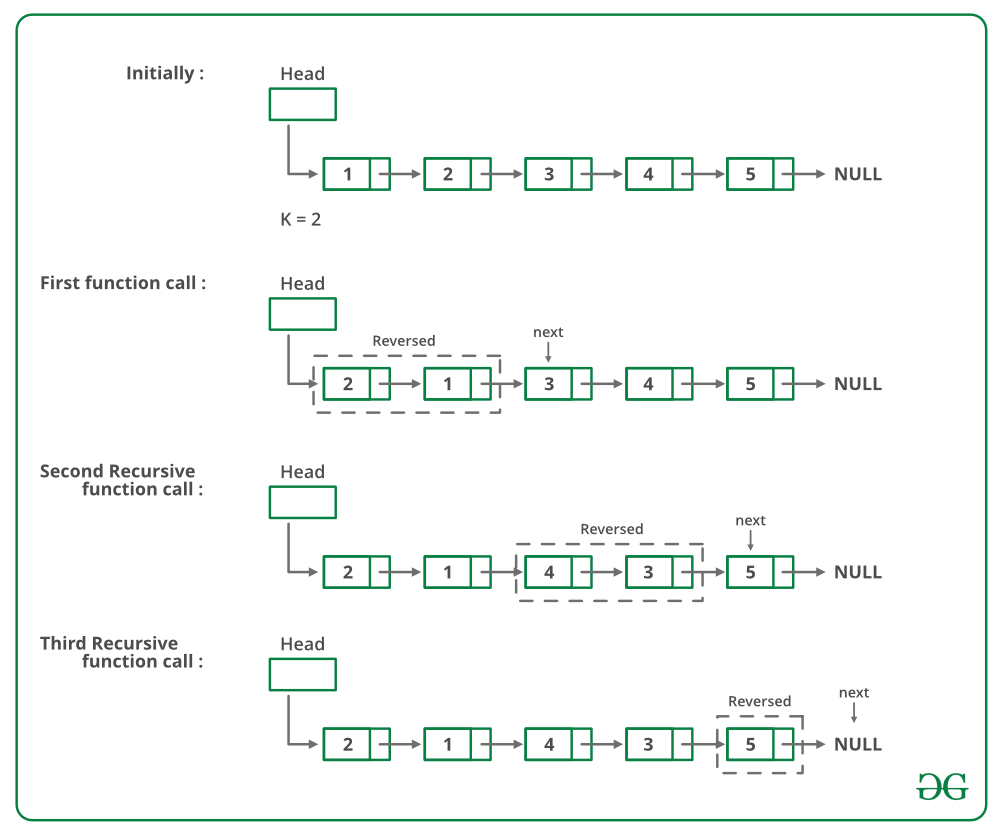Dada una lista enlazada, escribe una función para invertir cada k Node (donde k es una entrada a la función).
Ejemplo:
Entrada : 1->2->3->4->5->6->7->8->NULL, K = 3
Salida : 3->2->1->6->5->4- >8->7->NULO
Entrada : 1->2->3->4->5->6->7->8->NULO, K = 5
Salida : 5->4->3-> 2->1->8->7->6->NULO
Algoritmo : inverso (cabeza, k)
- Invierta la primera sublista de tamaño k. Mientras retrocede, realice un seguimiento del siguiente Node y del Node anterior. Deje que el puntero al siguiente Node sea next y el puntero al Node anterior sea prev . Consulte esta publicación para invertir una lista vinculada.
- head->next = reverse(next, k) (Llama recursivamente al resto de la lista y vincula las dos sublistas)
- Return prev ( prev se convierte en el nuevo encabezado de la lista (ver los diagramas de un método iterativo de esta publicación )
La siguiente imagen muestra cómo funciona la función inversa:

A continuación se muestra la implementación del enfoque anterior:
Java
// Java program to reverse a
// linked list in groups of
// given size
class LinkedList
{
// Head of list
Node head;
// Linked list Node
class Node
{
int data;
Node next;
Node(int d)
{
data = d;
next = null;
}
}
Node reverse(Node head, int k)
{
if(head == null)
return null;
Node current = head;
Node next = null;
Node prev = null;
int count = 0;
// Reverse first k nodes of
// linked list
while (count < k &&
current != null)
{
next = current.next;
current.next = prev;
prev = current;
current = next;
count++;
}
/* next is now a pointer to (k+1)th node
Recursively call for the list starting from
current. And make rest of the list as next of
first node */
if (next != null)
head.next = reverse(next, k);
// prev is now head of the input list
return prev;
}
// Utility functions
// Inserts a new Node at front
// of the list.
public void push(int new_data)
{
/* 1 & 2: Allocate the Node &
Put in the data*/
Node new_node = new Node(new_data);
// 3. Make next of new Node
// as head
new_node.next = head;
// 4. Move the head to point to
// new Node
head = new_node;
}
// Function to print linked list
void printList()
{
Node temp = head;
while (temp != null)
{
System.out.print(temp.data + " ");
temp = temp.next;
}
System.out.println();
}
// Driver code
public static void main(String args[])
{
LinkedList llist = new LinkedList();
// Create Linked List is
// 1->2->3->4->5->6->
// 7->8->8->9->null
llist.push(9);
llist.push(8);
llist.push(7);
llist.push(6);
llist.push(5);
llist.push(4);
llist.push(3);
llist.push(2);
llist.push(1);
System.out.println("Given Linked List");
llist.printList();
llist.head = llist.reverse(llist.head, 3);
System.out.println("Reversed list");
llist.printList();
}
}
// This code is contributed by Rajat Mishra
Producción:
Given Linked List 1 2 3 4 5 6 7 8 9 Reversed list 3 2 1 6 5 4 9 8 7
Análisis de Complejidad:
- Complejidad temporal: O(n).
El recorrido de la lista se realiza solo una vez y tiene ‘n’ elementos. - Espacio Auxiliar: O(n/k).
Para cada Lista Enlazada de tamaño n, n/k o (n/k)+1 se realizarán llamadas durante la recursividad.
Consulte el artículo completo sobre Invertir una lista vinculada en grupos de tamaño determinado | ¡ Establezca 1 para más detalles!
Publicación traducida automáticamente
Artículo escrito por GeeksforGeeks-1 y traducido por Barcelona Geeks. The original can be accessed here. Licence: CCBY-SA